Heavy Competition For Light Tank: SAIC & Singapore Vs. BAE, GDLS
Posted on
If the stars align for defense contractor SAIC, the US Army and Marine Corps will soon be buying hundreds of armored vehicles designed in Singapore.
Yesterday, six months after joining forces for the first time on the Marines’ Amphibious Combat Vehicle competition – and just four days before the massive Association of the US Army conference opens in DC – Virginia-based SAIC and Singapore Technologies Kinetics officially announced they are teaming up again for the Army’s Mobile Protected Firepower program, a light tank to support light infantry in places where the massive M1 Abrams cannot go.
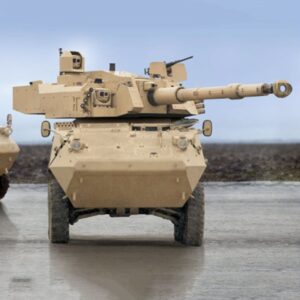
SAIC will replace the SIngaporean NGAFV’s current turret with CMI’s 105 mm turret
SAIC didn’t go in planning another team-up with STK, SAIC Defense Systems general manager Jim Scanlon told me. “We talked to a lot of different folks… around the globe, visited them and so forth,” Scanlon said. “It wasn’t preconceived going in” that they’d partner with the Singaporeans again, but “for the vehicle chassis, what STK was doing was the best.” SAIC plans to offer the chassis of Singapore’s brand-new Next Generation Armored Fighting Vehicle (NGAFV) with a Cockerill 3105 turret from Belgium’s CMI. Working closely together, Scanlon said, the team is “a viable alternative… to the more traditional GD and BAE.”
That makes two contracts now where the upstart SAIC-STK team is going head to head with defense giant BAE Systems. BAE makes the Army’s M2 Bradley, AMPV utility vehicle, and M109 Paladin howitzer. BAE also won the Army’s previous, cancelled program for a light tank: The M8 Buford Armored Gun System (AGS), which BAE is updating for MPF with new electronics, a new engine, and improved protection.
Unlike its rivals, who must come up with new tanks on a tight timeline, BAE’s benefits from years of painstaking, bespoke optimization for this exact role. “The requirement that was established in the ’90s really hasn’t significantly changed,” BAE’s VP for combat vehicles, Deepak Bazaz, told me. “We’re really purpose-built for that particular mission.”
The third, quieter contender is General Dynamics Land Systems, another established armored vehicle firm, which builds the Army’s M1 Abrams heavy tank and its eight-wheel-drive Stryker armored vehicles. Unlike SAIC and BAE, GDLS didn’t offer an interview for this article. From past statements and other published clues, however, they’ll likely offer an evolution of the Griffin demonstrator they showed at last year’s AUSA. Similar to the SAIC-STK design, the Griffin took an existing chassis, the British Ajax scout vehicle, and added a different turret derived from the M1. Unlike SAIC, however, GDLS builds both the Ajax and M1 itself, so it didn’t need a partner.
Big Gun, Small Tank
The Army hasn’t finalized its requirements so the competitors haven’t finalized their designs. The service has circulated multiple drafts of the requirements for comment. Nevertheless, it’s already possible to detect some definite differences.
When it comes to the F in MPF — firepower — both SAIC and BAE will use a 105mm cannon, a standard NATO caliber. GDLS’s Griffin, by contrasts, boasts a 120mm gun, the caliber that replaced 105s on heavy tanks in the 1980s. When I talked to GDLS last year, they sounded pretty proud of their lightweight 120, originally developed for yet another cancelled light tank, part of the Future Combat Systems program. They were proud of a gun turret set-up that functioned identically to the M1, which also has a 120 mm. So my bet is they stick with that weapon and turret combo, making them stand out as the literal big gun of the MPF competition.
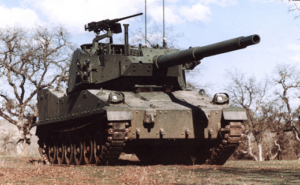
The M8 Armored Gun System, cancelled amidst budget cuts in 1996.
On the “mobile” side, BAE’s Armored Gun System looks like the lightest contender. Designed to be air-dropped alongside the 82nd Airborne, it can strip down to 19 tons to be parachuted into battle or additional armor can be layered on until it weighs 25 tons – although the new version may well gain some weight. GDLS’s Griffin weighs 28 tons, though their final design could be very different. By contrast, SAIC told me they expect their vehicle to weigh “in the 30-ton range.” The Singaporean NGAFV is 29 tons with its current turret, but it carries a much lighter gun, and the 105 turret will certainly add a few tons.
That means the SAIC vehicle, and probably the GDLS one, are too heavy to be dropped by parachute. Air-droppability is not a requirement for Mobile Protected Firepower – most MPF will go to regular infantry brigades, not the 82nd Airborne – but it’s a cherry on top that the prestigious airborne community would love to have. The stated requirement is simply for something much more air transportable than the M1 Abrams: The biggest Air Force transport that can land on a dirt airstrip, the C-17, can only carry one 70-ton M1, but the Army wants it to carry two MPFs at once.
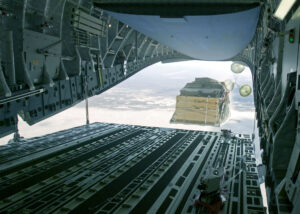
Airdropping an Army Stryker vehicle
That may not seem like a big difference, but for an airborne commander trying to build up his forces as fast as possible before the enemy decides to reenact the Battle of Arnhem in A Bridge Too Far, getting twice as many tanks per sortie, even if they’re smaller, can be a literal lifesaver. The stripped-down BAE Armored Gun System can flow to the front even faster, since it fits in the smaller C-130 transport, which is more common than the C-17 and can land on shorter fields. (And, of course, there’s the more recent experience of the 82nd in the first Iraq war, where the Defense Science Board described it as a “speed bump” because of its lack of heavy weaponry.)
Unfortunately, mobility and protection – the P in MPF – are at odds. The more armor you add, as the US found out in Afghanistan and Iraq, the harder it is to cross rickety bridges, frozen rivers, and precarious mountainside trails; the more fuel and spare parts you need; and the harder it is to fit on transports from ships to planes to railroad cars. BAE tried to square that circle with modular armor that could be built up and stripped down as needed, a technique both it and GDLS applied to the cancelled Ground Combat Vehicle, and I’m surprised that SAIC didn’t mention it.
But even taking armor on and off like sweaters can only adjust a vehicle’s weight and protection so much. In particular, for armored vehicles as for middle-aged humans, Bazaz said, “it’s harder to lose weight than to put on a couple of pounds.”
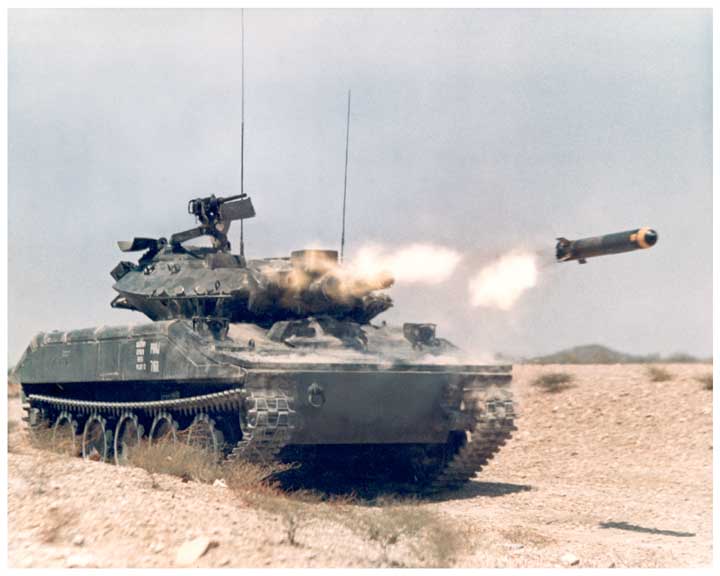
M551 Sheridan
What’s Different This Time?
The tradeoffs of the so-called iron triangle – mobility, protection, and firepower – have killed or crippled every Army light tank program since 1950, when the M41 Walker Bulldog proved simultaneously too big for airdrops or reconnaissance but too small to fight Russian tanks. The lighter M551 Sheridan made it into combat in Vietnam and Panama, but it was alarmingly vulnerable and the recoil of its oversized gun tended to break its electronics. The M8 Armored Gun System and the Future Combat System were both cancelled. The Stryker Mobile Gun System, the only wheeled attempt to fill this role, fought in Iraq and Afghanistan but never overcame a troubled development.

M41 Walker Bulldog
Even the iconic M4 Sherman of World War II is an example of how tradeoffs can go wrong. Designed to fit easily on transport ships and to cross bridges, it was mobile, reliable, and deadly against older German tanks, but heavy Panthers and Tigers slaughtered it.
As Breaking D readers know, Army acquisition has a lousy track record in recent years on any kind of program. So how will this time be different? “The Army did a really good job of not shooting for the stars,” Bazaz said. Excessive high-tech ambition doomed FCS, which tried to pack the firepower and protection of a 70-ton M1 into a 20-ton vehicle. The Sheridan and Mobile Gun System simply had too much gun for their chassis to handle. (AGS’s cancellation, by contrast, was almost entirely about budget).
This time, the Army has consulted industry about the art of the possible and restricted contractors to proven, off-the-shelf, technology. The service wants MPF to be easy to upgrade, with an open architecture for electronics, adequate electrical power and space for a future Active Protection System, and the potential to one day operate unmanned – but for now, it needs to be a Non-Developmental Item (NDI).
“There is no time to mature technology,” said Bazaz. “It’s really an integration job that we’re performing here.”
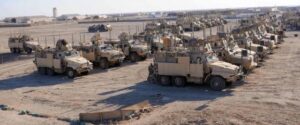
MRAPs in Iraq
And integration, Scanlon says, is SAIC’s specialty. While the company is new to the armored fighting vehicle business, they’ve worked on more than 40,000 MRAP mineproof trucks and other vehicles since 9/11, mostly integrating electronics but in many cases adding additional armor and even replacing the engine. As for SAIC’s partners, the CMI turret is already in production, while the STK chassis is just starting production for the Singaporean army after a decade of development and testing. But will all that groundwork let Team SAIC build their new machine at the same pace BAE updates their old one?
Speed is critical. The Army Chief of Staff, Gen. Mark Milley, is trying to accelerate the sclerotic acquisition system, and MPF is a poster child for a faster, more disciplined way of buying weapons. The final Request For Proposals is expected in December, with the companies submitting their designs and one working vehicle each in March, and a final decision by early 2019. Isn’t that a blisteringly fast schedule for an Army procurement program? Scanlon said: “It’s aggressive.”
Subscribe to our newsletter
Promotions, new products and sales. Directly to your inbox.
